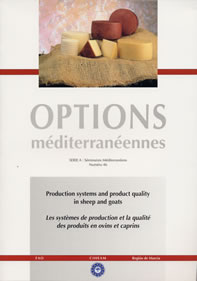| Article précédent | p. 201-205 | Article suivant |
Study of the goat production system and the quality of milk produced in the Sierra Norte of Seville (Spain)
The objective of this study is to determine the situation of semi-extensive goat farms, in the Sierra Norte of Seville (Spain), related to the bacteriological and hygienic quality of raw milk. Twenty percent of the farms were characterized, covering aspects related mainly to the milking and hygienic management. The bacteria and somatic cell content of raw milk coming directly from the udder and from churns (first at the end of the milking and second few hours after milking), were monitored for nine months in 14 farms. Besides, all the farms hold general sanitary norms, most of them do not carry out the general dairy herd recommendations for milking routine. It is observed that most germ contamination in milk occurred in the hours after milking, always below the maximum allowed. Somatic cells in all farms with more than 50 goats are above 1,500,000 somatic cells per ml..
- [ Afficher ]
- [ Télécharger ]
- [ Exporter la citation ]
Vous pouvez télécharger la citation au format :
- [ Imprimer ]
-
Mots-clés
BACTERIE, CAPRIN, ELEVAGE, HYGIENE, LAIT, QUALITECiter cet article
Mena Y., Delgado-Pertiñez M., Alcalde M.J., Castel J.M., Caravaca F., Ramírez E., Gousse S., Guzman J.L. Study of the goat production system and the quality of milk produced in the Sierra Norte of Seville (Spain). In : Rubino R. (ed.), Morand-Fehr P. (ed.). Production systems and product quality in sheep and goats . Zaragoza : CIHEAM, 2001. p. 201-205. (Options Méditerranéennes : Série A. Séminaires Méditerranéens; n. 46). Meeting of the Sub-Network on Production Systems of the FAO-CIHEAM Inter-Regional Cooperative Research and Development Network on Sheep and Goats, 1999/09/23-25, Molina de Segura-Murcia (Spain). http://om.ciheam.org/om/pdf/a46/01600137.pdf



